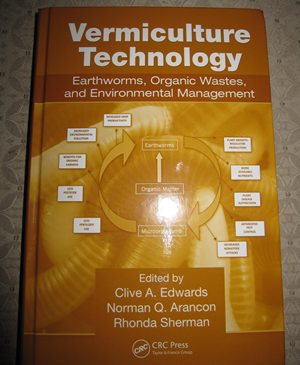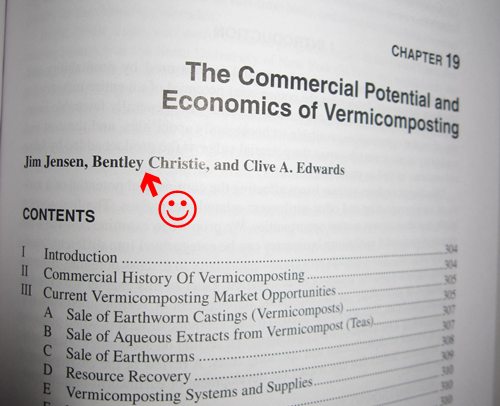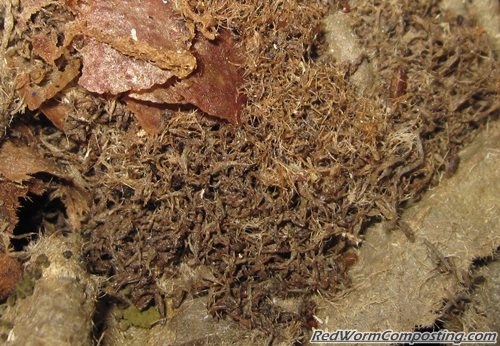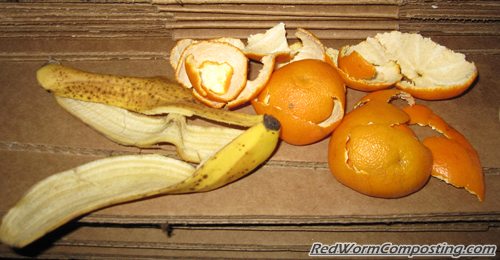January 2011
600th RWC Blog Post!

There’s a famous saying, “The journey of 1000 miles begins with a single step” – well, as I reflect back on the 600 blog posts that have been posted here since late 2006, I just can’t help but appreciate the wisdom in these words!
I often get overwhelmed when faced with any huge/extensive project, but as I’ve discovered, there is real magic in consistent “baby steps”!
Thanks everyone for all your wonderful feedback and support over the years. All those positive vibes have served as “fuel” to keep me plugging away! Interestingly enough, we just hit 5000 comments a matter of days ago as well!
I’m looking forward to hammering out another 400 posts, and beyond. It’s only going to get better from here!
8)
Vermiculture Technology

Hi Everyone!
Sorry things have been so quiet as of late – haven’t quite bounced back from my holiday slumber I guess!
🙂
Today I wanted to let everyone know about a brand new vermicomposting/vermiculture book, published by CRC Press.
It’s actually been a project sitting on the backburner for quite a few years, as indicated by various contributions from those no longer involved in the field, but the content is absolutely stellar – especially if you are interested in the large-scale/commercial and/or academic research side of things.
Here are the chapter titles:
1) Introduction, Hostory, and Potential of Vermicomposting Technology
2) Relationships between Composting and Vermicomposting
3) Biology and Ecology of Earthworm Species Used for Vermicomposting
4) Discovery and Development of New Species for Vermiculture
5) The Microbiology of Vermicomposting
6) Small-scale School and Domestic Vermicomposting Systems
7) Low-Technology Vermicomposting
8 ) Medium- and High-Technology Vermicomposting Systems
9) The Potential of Vermicomposts as Plant Growth Media for Greenhouse Crop Production
10) The Use of Vermicomposts as Soil Amendments for Production of Field Crops
11) The Production of Vermicompost Aqueous Solutions or Teas
12) The Suppression of Plant Pathogens by Vermicomposts
13) Use of Aqueous Extracts from Vermicomposts or Teas in Suppression of Plant Pathogens
14) Suppression of Arthropod Pests and Plant Parasitic Nematodes by Vermicomposts and Aqueous Extracts from Vermicomposts
15) The Use and Effects of Aqueous Extracts from Vermicomposts or Teas on Plant Growth and Yields
16) Human Pathogen Reduction during Vermicomposting
17) Heavy Metals, Earthworms, and Vermicomposts
18) Quality Criteria for Vermicomposts
19) The Commercial Potential and Economics of Vermicomposting
20) The Production of Earthworm Protein for Animal Feed from Organic Wastes
21) The Use of Vermiculture for Land Improvement
22) The Potential of Earthworms Produced from Organic Wastes in Production of Pharmaceuticals
23) The Status of Vermicomposting in North America: A Rapidly Developing Technology
24) Vermicomposting for Business Institutions
25) New Developments and Insights on Vermicomposting in Spain
26) Vermiculture and Vermicomposting in the United Kingdom
27) Vermiculture in Australia and New Zealand: From Earthworm Production to Commercial Vermicomposting
28) Origins and Spread of Vermicomposting in India: Focus on Sustainable Agriculture
29) Vermiculture in the Philippines
30) The Status of Vermicomposting in Indonesia
31) Vermicomposting Projects in Hong Kong
32) Vermicomposting Research and Activities in Mexico
33) The Scope of Vermiculture in Cuba
34) Commercial Applications of Vermiculture in China
35) Progress in Vermicomposting in Belarus, Russia, and Ukraine
Phew!! That took some typing, I gotta tell ya!
😆
Those of you who know me well, know I tend not to be the type of guy to toot my own horn but…
(WARNING: imminent horn tooting!)
…I just can resist! lol
Last year I received an email from Dr. Clive Edwards (who had become a pretty good email friend by then) asking if I’d be interested in helping out with one of the chapters in the book. Let me point out right off the bat that I did NOT write the chapter – Jim Jensen deserves primary recognition for that. My job was basically to work through the content (which was written quite a number of years ago) and to help Dr. Edwards update/modernize it.
In all honesty, I protested the fact that he wanted to include my name at all, but he insisted (which meant that I was among those who received a free copy of the book as well) thus twisting my rubber arm into submission.
😆
I won’t lie to you – this is NOT an inexpensive book (tends to be the case with high caliber academic publications)! The “regular” price is a whopping $119.95, unfortunately. I should mention, though, that they currently have an introductory special, if I’m not mistaken – $95.96 + Free shipping until January 21st. Only problem is that I don’t know how to access this deal – the regular price is the only one listed on the product page:
Vermiculture Technology.
I was excited to see that they have an “eBook” version, but oddly enough it seems to be the same price (which completely baffles me, if that is indeed the case).
Anyway – I have been in communication with CRC editor, John Sulzycki, and am hoping to hear back about all this.
Stay tuned!
8)
BOM-6000 Update
As seems to be the case every year, I ended up completely neglecting ALL my worm composting systems over the holidays. Now that I am starting to get back into “real world” mode, I’ve been spending some time checking on things.
Neglecting enclosed plastic bin systems almost never causes issues – in fact, it can actually be really beneficial in a lot of cases! I’d say this was definitely the case with my BOM-6000 system.
As some of you may recall, this became my “cofee grounds vermicomposting” bin in the fall after emptying the contents of my wooden stacking system into it. I ended up cutting the (BOM coffee grounds) experiment short when it appeared that the worms were not responding favorably to a grounds-only (apart from egg shells and cardboard) diet, and started adding typical worm bin food scraps.
The last time I checked on the bin (may have been as long ago as October) it was getting a bit stinky due to the large quantity of frozen food waste I had recently added. Certainly no longer the case!
😆
You can always gauge the degree of worm bin neglect by the amount of bedding material that’s been consumed by the worms. Needless to say, I found LOTS of paper-pulp worm castings when I opened up the bin today!
Interestingly enough, I couldn’t find any indication of the presence of coffee grounds in the bin, other than a zone of really dark castings down towards the bottom! Everything smelled wonderfully earthy when I dug around a bit, and I was happy to see that the moisture content is still at a reasonable level.
In an effort to get things back on track in this system, I added some fresh cardboard at the top then dumped in a decent amount of frozen food waste.
Once it thaws out I will likely add a fair amount of shredded cardboard over top.
——–
OK – that’s it for this update. I’ll let everyone know what’s going on with my neglected Worm Inn and Winter Worm Windrow systems sometime soon!
🙂
Drying Food Scraps for Vermicomposting
Happy New Year everyone!
Definitely time to get things rolling here again after a bit of a holiday break.
I received an interesting email from someone a little while back. One of their questions had to do with drying out food scraps prior to adding them to a worm bin. Specifically, they had come across information suggesting that drying out citrus peels prior to vermicomposting can make them less potent (and thus easier for the worms to process).
I’ve never heard of this myself, but it sounds perfectly reasonable. After all, I know how much of a difference there is between dried grass clippings and fresh grass clippings (the former being FAR more potent and thus more challenging to work with), so I wouldn’t be surprised if this holds true for a variety of materials.
Anyway, I thought it might be fun to dry a bunch of different food scrap materials before attempting to vermicompost them. I’ll be keeping a running tally on the total quantity of material (“x number of banana peels, orange peels, apple cores etc) and the total fresh weight so I can make comparisons with the dried wastes and know what fresh-weight-equivalent I end up vermicomposting.
Should be fun! Stay tuned.
8)





